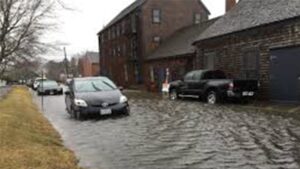Climate change is projected to continue resulting in a variety of physical effects, including sea level rise and changes in patterns of temperature, precipitation, and extreme weather events . These effects will in turn have implications for ecosystems, government (look at the riots in Syria driven by drought) , human health, systems, such as buildings, industrial processes, transportation, energy supply and demand, and infrastructure. It will increasingly affect design of everything from gutters to site development, roofing to framing anchorage. The building codes are lagging behind and of course only represent minimum standards. https://seconarchitect.com/drainage-basics-stormwater-management/
Simply put, the ever-increasing carbon dioxide levels trap heat in our atmosphere, which in turn makes the air more capable of holding higher levels of moisture. Among the adverse results are higher rainfall intensity and expanding water bodies with higher sea-levels. When rainwater goes where it is supposed to, drainage tends to be easily overlooked. As new rainfall patterns emerge, we have to carefully gauge the new “normal”. When you have lots of construction, new roads, and a higher intensity of rainfall combined with little heed as to how the “run-off” from a rainstorms will get back into the earth: you have genuine problems.
Welcome to Westchester County, NY 2013 where roads often flood, entire regions of low lying towns struggle with storm after storm, and surface water control issues continue to get worse. The confluence of higher rainfall intensity and less pervious area to soak in the water is causing more flooding and reluctant insurers. Major objectives in response to this include raising the allowable level that one may build (i.e. to stay out of potential flood zones) and mitigating the flow of rainfall into a rational collection and dispersion.

The general water management strategy is to slow the flow of water to minimize erosion, hold the water and then try to disperse it by guiding the run-off into areas that will let the water seep out slowly. This is often done by a system of drains, gutters, leaders and seepage pits (drywells) or connections to sewers. There are many types of drainage devices and they vary in size based on how much water they will control, maintenance requirements and the drainage characteristics of the soil of the site. https://seconarchitect.com/just-dirt/
So, if you or somebody you know is having trouble with flooding, puddles or just a wet basement and needs to talk about cost-effective solutions that look great and last, please ask them to call Steve at 914 980 5532…oh by the way… Mother Nature bats last.

